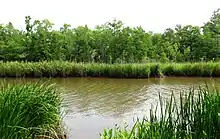| Battle of Wambaw | |||||||
|---|---|---|---|---|---|---|---|
| Part of the American Revolutionary War | |||||||
 The Wambaw Creek. | |||||||
| |||||||
| Belligerents | |||||||
|
|
| ||||||
| Commanders and leaders | |||||||
|
Major William Benison † Col. Archibald McDonald | Lt. Col. Benjamin Thompson | ||||||
| Strength | |||||||
| ~500 | ~700 | ||||||
| Casualties and losses | |||||||
|
10 killed 8 wounded | 1 wounded | ||||||
The Battle of Wambaw was an engagement of the American Revolutionary War fought on February 24, 1782 near Charleston, South Carolina.
Background
In January 1782, Brig. Gen. Francis Marion was elected to the South Carolina General Assembly and left to take his seat, relinquishing command of the militia forces to Lt. Col. Peter Horry, who lead the men to set up camp along the Wambaw river. Soon after, Horry fell ill and returned to his plantation home to recover, leaving command to Major William Benison.
Battle
Loyalist Lt Col. Benjamin Thompson learned of the patriot camp and planned an attack on it. He assembled a force of around 700 menmade up of elements from the Volunteers of Ireland, the 13th Regiment of Foot, Maj. John Coffin's dragoons, and the Independent Troop of Black Dragoons. Thompson led his men out in the early morning of February 23.
The next day, patriot scouts reported to Major Benison that they had seen British forces marching toward their position, but he dismissed the report. Later that day, British forces attacked the camp, forcing the militia forces to retreat across the river over the Wambaw ridge. Patriot forces tried to make a stand on the high ground across the river, but were forced to retreat from there as well. Thompson called off the attack at night fall. Major William Benison was killed in the battle.[1][2]
Sources
- ↑ McCrady, Edward, The History of South Carolina in the Revolution, 1780-1783, Macmillan & Co., Ltd., 1902 pp. 601–604
- ↑ "The American Revolution in South Carolina - Wambaw Bridge". www.carolana.com. Retrieved 2023-03-19.
